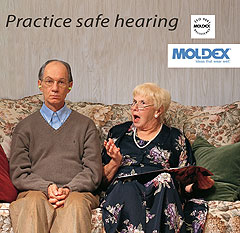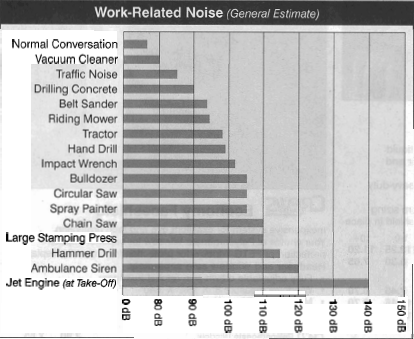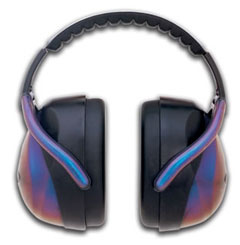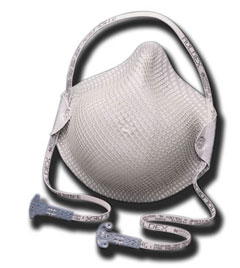
It’s not easy making safety gear engaging, but if there is one company that manages to do just that, it is Moldex. They first caught my eye with an advertising poster for noise abatement earplugs that had me laughing out loud. In it, an obviously henpecked milquetoast wears Moldex earplugs that allow him to sit in peaceful oblivion amid the verbal assaults of his loquacious couch mate.
Granted, a good sense of humor, while welcome, is beside the point where safety is involved, so it was even more gratifying to find that they take their work quite seriously. Moldex offers woodworkers a range of respiratory and hearing protection that is effective, comfortable, attractive and superbly designed. Perhaps just as important, their products are quite affordable.
That made me curious about their background. After all, how does a company find itself in the business of making dust masks and earmuffs? In this case, the history, recounted on their sister company’s web site, is rather revealing. Moldex is part of Metric Products, Inc., its forebear and other half, which sells molded cups and underwires for women’s bras and swimwear.
In 1947, Shirley Magidson, an industrial designer, and her husband Herbert, a mechanical engineer, began by manipulating wire, initially supplying axles for Mattel’s toy cars. They were soon deluged with specialty requests, and came to the attention of Helene of Hollywood, which was looking for underwires for its bras and swimwear. Before long, Metric was creating molded cups for bras and bathing suits. Moldex, the safety division, was created in 1980, allowing the company to apply the molding and foam technology that they had developed to the field of worker safety. Today, some 300 employees make over 30 different items.
In a recent issue of the eZine, one of our readers complained that while we often talk about safety gear, we don’t adequately explain what is needed and what to look for. With that in mind, I asked Rick Marquez, the v.p. of sales for Moldex, to help us out with a crash course on safety gear. He started with hearing protection.

“First and foremost,” Rick began, “most people do not know how damaging some woodworking machinery is to their hearing. At least in part, that is because it is cumulative, and hearing loss often goes unnoticed in its early stages. You should wear hearing protection when you are exposed to anything over 85 decibels. To put that in perspective, normal conversation is in the range of 65 decibels. A hand drill is close to 100, and a belt sander is about 90. The long and short is that you should probably be wearing hearing protection any time you turn on a woodworking machine.
For those worried that wearing muffs might prevent them from hearing other people, or hearing noises necessary for their safety, Rick assured me that hearing protection blocks out harmful frequencies, but allows you to hear normal frequencies. That means you can still hear the machine’s motor, and you can even hear someone talking to you.
“Moldex makes both muffs and in-ear protectors,” Rick continued. “Which you use is based on personal preference, since either type will protect you. Some find ear canal protection more comfortable, while others prefer muffs. Obviously, it is important to find ear protection that is comfortable for you, but beyond that, look for the ability to effectively block out noise. Anything above an NRR (noise reduction rating) of 25 should be adequate for woodworkers. You can get that with either type alone. Wearing a combination of both will only give you about another four or five points in noise reduction, so in most cases, that is not necessary.”

The Moldex line includes several types of earmuffs. Some are foldable, some can be worn with the band above, below, or behind the head, and some clip onto protective helmets. In-ear models include disposable foam plugs and flanged, soft plastic plugs that are reusable. All of the in-ear products fit most people. Foam ear plugs cost about 15 cents per pair, while reusable models cost about a dollar. Muffs start from around $15. All in all, that’s not much money for protecting your hearing.
We then moved on to dust masks. Once again, Rick reminded me that dust exposure is cumulative, and also gives few if any advance warnings, though some wood dusts are immediately harmful, and can an allergic reaction. Any time you are cutting or sanding wood, even if you have dust collection on the machine, you should be also wearing a dust mask.
What type will you need? “It is difficult to answer that because of the variables involved,” said Rick. “We can’t really suggest a proper type of respiratory protection unless we know the variables.” However, the so-called “nuisance masks” are not approved by NIOSH (National Institute of Occupational Safety and Health) for any reason, and therefore, Moldex does not make them.
Rick explained that fitting, while not particularly simple, is nonetheless a major consideration. “It’s important that the mask is fitted correctly, even though it means you will have to breathe a bit heavier while wearing one. If you call any company, including us, they will tell you that proper fitting requires a testing kit with a hood.”

While there is no practical homespun test, you should at least check to make sure the mask fits your face securely by following the instructions on the package. While that may not be the ideal test, it is certainly better than abandoning safety gear completely. Marquez also pointed out that short of wearing a supplied air hood, you won’t get as good a facial fit if you have a beard. Their official recommendation is that those with beards should use a powered air respirator.
The rating system for dust is quite intuitive. A NIOSH approved respirator with a rating of 95 means it is 95 percent efficient at filtering dry particulate, and that is the minimum woodworkers should be wearing. Some of the Moldex high efficiency masks, even disposable ones, like their 2730 N100, are more than 99.9% efficient. The point is, your protection can be both cost-effective and comfortable, and still provide very significant protection.
One of the neatest features on some of their disposable masks, and my personal favorite, is their HandyStrap®. It is a single, long, cotton strap that snaps behind your neck to form a double strap, which adjusts easily and is very comfortable. Best of all, you can unhook it, and the mask stays hanging around your neck, ready to go back on as soon as you need it. Those who spray need more than a dust mask. For them, Moldex makes their 8000 series, which, paired with an organic vapor cartridge, will handle most of the common finish solvents you are likely to use.
Moldex distributes nationally, and their web site lists a wealth of dealers and outlets, many of whom sell online. You can also call 800-421-0668 to find the dealer nearest you.
Of course, no safety gear is of any use unless people agree to wear it. That’s why I was so pleased to hear Rick’s answer when I asked him what sets Moldex apart from the competition. He said, “Simply put, our products are more comfortable.”





